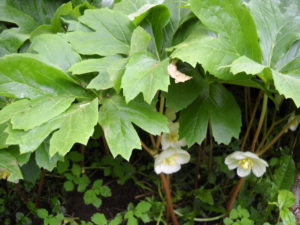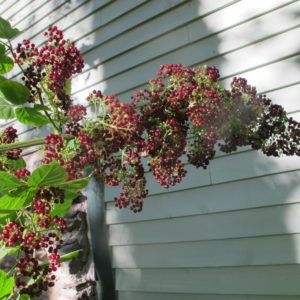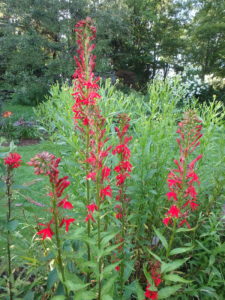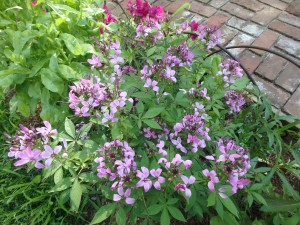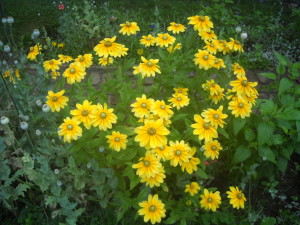Native Plants for New England Gardens
It’s rare that I find a book that is as useful, accurate and easy-to-read as Native Plants for New England Gardens by Mark Richardson and Dan Jaffe, both on staff at the New England Wild Flower Society in Framingham, Massachusetts. This book presents over 100 species of wildflowers, trees and shrubs, grasses, ferns, vines and lianas (woody vines). And even though I grow the vast majority of plants in this book, I learned so much that I felt like a third grade boy on an outing with a PhD.
First, the authors define native plants: those that were growing in North America when the first colonists arrived. They stress, right of the bat, that it is important to put the right plant in the right place. Instead of shopping for pretty flowers, they recommend knowing about plants and seeking them out. The glossy photos of the book will help you put together a plant list; their instructions will help you decide if you have a place for a particular plant.
I have always enjoyed eating wild harvested plants. The book covers ramps, which I grow, but also other wild edibles I grow – including two that I didn’t know are edible.
I have a large patch of Mayapple (Podophyllum peltatum). As the authors point out, it spreads robustly and shades out other plants. The blossoms appear beneath the big, wide leaves and are not easily seen; they suggest planting it on a steep incline, so that one can see them – and the fruit, bright red “apples” when standing below the planting. I have seen the fruit, but never knew it was edible until reading about it. Apparently the fruit is also eaten by box turtles. Who knew?
Another edible fruit described in the book is produced by American spikenard (Aralia racemosa). The authors note that spikenard gets big enough to serve as a handsome shrub, but since it dies back to the ground each fall, it won’t be damaged by snow falling off your roof if you plant it near the house. I grow it in part shade and it gets to be 6 feet tall and wide, and produces masses of berries each fall. The berries start off white, change to red, and end up a deep purple. I shall taste them this fall.
I grow all 3 of the milkweeds described in the book: common, swamp or rose, and butterfly milkweed. The authors explain the plusses and minuses of each, where to plant them. “If you are looking for a well-behaved garden plant, then common milkweed is not the best choice.” It spreads by root, they explain and is suited for “meadows, hell strips or as competition against invasive species.”
Yes, I knew that milkweeds are essential for monarch butterflies, but they point out that they also support tussock moths, swallowtails, and a variety of beneficial beetles. “The plant (swamp milkweed) seemingly supports whole ecosystems on its own, often playing host to bees, ants, and various spiders waiting to eat an unsuspecting pollinator.”
I love cardinal flower (Lobelia cardinalis) and have grown both the native species and modern hybrids varieties in a moist, full-sun garden. I no longer grow the hybrids, as they are less hardy than the native species and have all died out. The authors refer to work done at the University of Vermont that showed that at least one of the hybrids produced only 20% of the nectar energy produced by the wild species. So hummingbirds, who love these bright red flowers, get something akin to diet nectar if you grow the hybrid variety. It’s best to avoid planting them, so read the plant tags carefully before buying.
I love the bright red leaves of staghorn sumac (Rhus typhina) growing by the side of the road, but would never consider planting it on my property. Although a native plant with fruit beloved by returning migratory birds in early spring, it can spread very aggressively and is hard to remove. But the authors introduced me to another variety, fragrant sumac (Rhus aromatica), that is smaller, “much slower growing, and fairly easy to control even in a formal garden setting.” I shall look for it, and try to learn from others who have grown it (Please e-mail me if you have grown it).
I grew up in Connecticut where spicebush (Lindera benzoin) was a wild shrub with tasty leaves and twigs that I chewed as a breath freshener. But it is hardy to Zone 4, and I got one two years ago. According to the book, it is an understory shrub that does well in moist soil. I knew it as a plant for dry shade, and hence planted it here in a dry location, and it has done fine.
What I did not know, until reading Native Plants for New England Gardens, is that spicebush is dioecious – there are male and female plants. That would explain why I have not gotten any of the bright red berries used by the authors in a tea that is “magical for fighting off the common cold and is packed with vitamin C.” I shall get another, and hope for pollination.
One last tip from the book: if you want to grow wintergreen, a low-growing ground cover with tasty red berries, plant it under your blueberries. The sulfur you give your blueberries will make the soil right for wintergreen.
I loved this book. I predict you will, too. And come spring, I’ll go to the Garden in the Woods in Framingham, MA (where the authors work) and buy some wildflowers in the nursery there.
You may e-mail Henry at henry.homeyer@comcast.net or write him at P.O. Box 364, Cornish Flat, NH 03746. Please include a SASE if you want a response by USPS mail.
Mid-Summer Blues … and Reds and Yellows
It’s been a hot dry summer and many gardeners are lamenting the lack of color in their flower gardens. While it’s true that this is a quiet period for many perennials, there are plenty of flowers that are blooming – and plenty more on the way. Let’s take a look.
First, there are the annuals. Annuals are flowers that only get one chance to continue their genetic line. If they don’t make seeds and get them in the ground, they will die out. Of course, those silly flowers don’t realize that all the big seed companies have plenty more seeds with similar or identical genetic material, and will be selling seeds for flowers just like them next year. But, not knowing that, annuals keep on blooming in hopes of perpetuating their genetic line.
Some annuals need to be dead-headed in order to keep blooming. We have to play the role of the deer or woodchuck or cow that might nip off the blossoms, signaling a need to produce more flowers and eventually seeds. If you don’t cut off the spent blossoms, the flowers will think they have down their job.
Annuals that need to be deadheaded include, but are not limited to the following: bachelor buttons, cosmos, gaura, gazanias, geraniums, marigolds, osteospurmum, pansies of all types, pincushion flower, salvias, snapdragons, sunflowers, verbenas and zinnias. Some of those, like marigolds and zinnias will bloom for long periods of time even if you don’t cut off the spent flowers. Many will branch and produce greater numbers of flowers after deadheading – cut off one snapdragon stem, get six more, for example.
Other annuals have been bred so that they are “self-cleaning.” That means that spent blossoms fall off and are replaced by new ones. Most impatiens are like that, along with some petunias. I have one petunia called ‘Night Sky’ from Burpee that has been blooming constantly since early June and all I have ever done is water it occasionally. What else? Angelonia, Supertunias, Superbenas, Million Bells (Calibrachoa), portulaca, dragon wing begonias, lantana, nemesia, torenia and oxalis.
Two of my favorite self-cleaning annuals are trademarked varieties (Proven Winners) and are not available in six-packs or by seed, only in pricier 4-inch pots. But they are worth it. First is ‘Senorita Rosalita’ cleome. Unlike the generic cleome, it has no spiky thorn-like appendages and no cat-pee odor. It is a multi-stemmed beauty about 24 to 36 inches tall with 4-inch wide clusters of frilly pink flowers. A knockout. Another is a euphorbia called ‘Diamond Frost’. This has a mass of tiny white flowers, a bit like baby’s breath, that keeps blooming forever. I have grown it in pots and brought them inside for the winter, and it keeps on blooming! Fabulous.
Then there are the perennials. Yes, June has passed and the peonies and primroses and iris have all finished blooming. But there are nice things now: purple cone flowers, black-eyed Susans, phlox and cardinal flowers are all blooming for me now. They are easy, sun-loving flowers that do well in a vase, too.
A few words of advice about the perennials above: in general, the old standards fare better than many of the “new, improved” varieties. And I say that not as an old curmudgeon who doesn’t like change, but as one who has tested many kinds.
So, for example, I have planted hybrid cardinal flower (Lobelia cardinalis), only to have them die after the first winter – even when the pure species plants I had did not. That said, I‘ve had even my best cardinal flower plants die out after a few years. It is not a long-lived plant. It needs moist soil – it is found along the banks of the Connecticut River and I saw a huge patch alongside an abandoned beaver dam this week.
Similarly, I’ve had much better luck with standard varieties of purple cone flower (Echinacea purpurea) than the new hybrid colors such as peach, or yellow. I’ll stick with the old-fashioned pinky-purple ones, thank you very much.
Phlox is an old-fashioned plant, but many of the new named cultivars really are better. They’ve been bred to resist mildew, which makes so many of the old varieties ugly with spotted brown leaves. ‘David’ is a white one that I grow that is very nice.
I love a black-eyed Susan called ‘Prairie Sun’. It rarely over-winters for me, but I accept that flaw because it blooms profusely from July until October. I generally purchase some every year. It is not a hybrid, so sometimes the plants will self-sow, providing free plants. Right now mine are gorgeous.
In order to have blooms all the time – which I do from March to November – you have to keep on buying plants, trying plants, replacing plants. There is no “quick fix.” So visit your gardencenter and ask what they have to brighten up your garden now.
Read Henry’s blog twice weekly at https://dailyuv.com/



